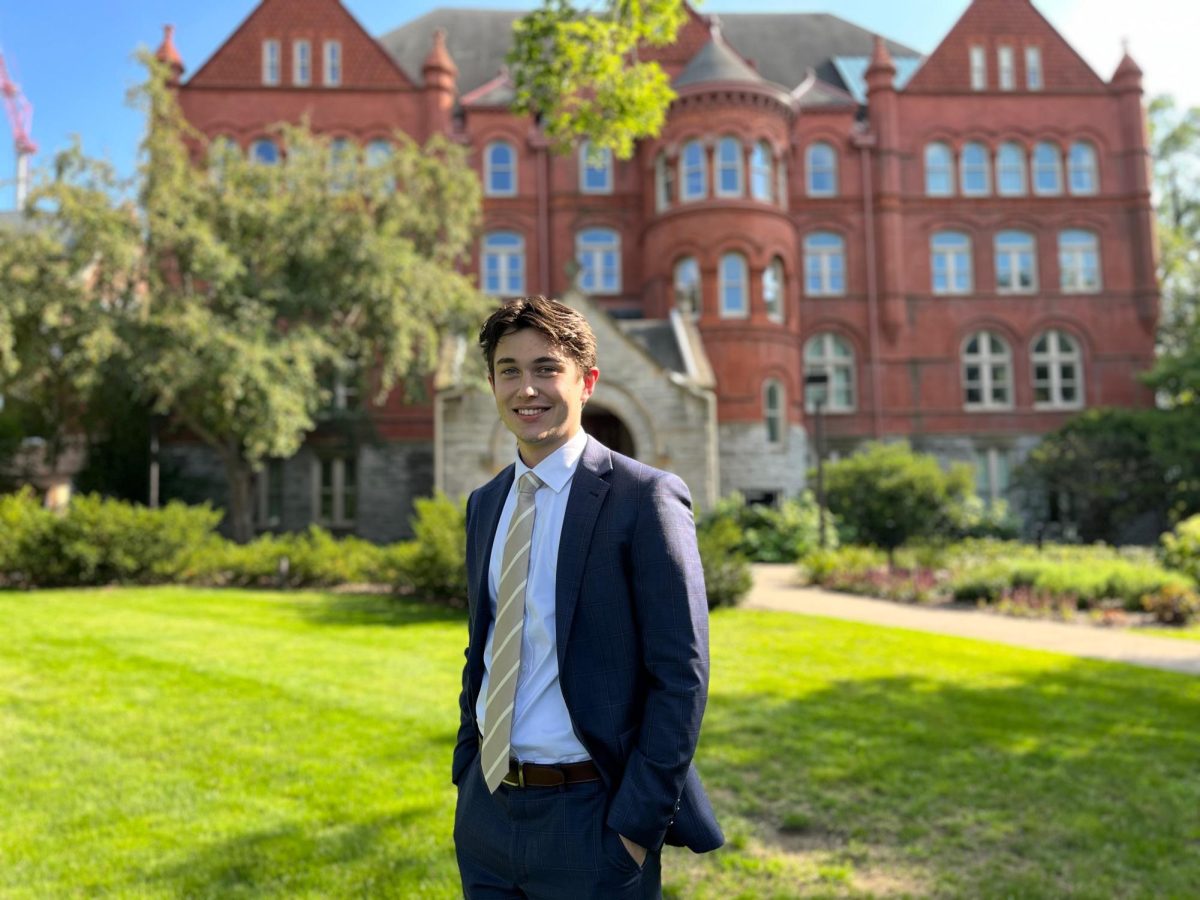
Questions about Macalester’s windmill have been blowing around campus for quite some time now. Many who have passed beneath the three-bladed enigma have gazed up, perplexed, wondering things like: Who was responsible for its building? How much energy does it supply? Does it even work? The Mac Weekly set out to explore the origins and role of the wind turbine.
The history of Durban the urban wind turbine, as some have affectionately nicknamed the tower, dates back to the early 1990s. At this time, Xcel Energy, the large Minnesota-based utility company, was hankering to expand its nuclear storage facilities. The Minnesota State Legislature eventually allowed for this on the condition that Xcel donate money to the research and development of sustainable energy sources. Through that, Xcel donated $35,000 towards the manufacturing of the wind turbine to be placed on Macalester’s campus.
While the college originally looked into building the turbine at the Ordway Field Station, biology professors, along with the provost at the time, were opposed to the idea. Eventually, the turbine’s current site was chosen. Unfortunately, Macalester still needed to provide the roughly $16,000 needed for the turbine’s installation.
That’s where students came into the picture. Dan Moring ’03, who had been working with MPIRG on clean energy issues at both the campus and state level, saw this as an opportunity to use the 2003 Senior Class Gift to make a long-lasting impact. Moring joined the Senior Gift Committee and brought up the idea to other committee members. Backed by student orgs, the issue was pushed along, and the Committee ended up raising about $15,000 for the footings, tower and labor that went into the turbine’s assemblance.
After the turbine was installed, Moring, along with friend Richard Graves, started the student organization MacCARES to make sure that “it wouldn’t be a one-off token symbol, but something that inspires much greater and more impactful efforts,” according to Moring.
While the installation of the turbine all seemed like relatively smooth sailing up until this point, there was some pushback from community members. According to Tom Welna, Director of the High Winds Fund, some residents of the area had concerns about noise, the danger the turbine would pose to migrating birds, and ice falling off of the turbine’s blades.
This was an issue when it came to the college obtaining a building permit from St. Paul. While there were no permits available at the time for wind turbines, the college was able to apply for a “similar use” permit. In this case, the wind turbine was said to have a similar use to a cellphone tower. Those opposed to the building of the turbine were a relatively small minority, but they made their voices heard.
“They tend[ed] to be vocal and seem[ed] to have endless amounts of time to attend public meetings,” Welna said.
This led to debate between the two sides at many different levels, from neighborhood councils all the way to the St. Paul City Council. According to Welna, though, the vocal resistance was met directly.
“We did not navigate around the resistance, we confronted it head-on,” Welna said.
This led to wind energy experts being called in to determine the level of hazard that the turbine would pose to birds and to address the issue of ice. It was determined that due to the high level of noise caused by traffic on Snelling Avenue, it wouldn’t be possible for neighbors to hear the sound of the wind turbine.
Eventually, the college was granted a one-year building permit for the turbine. The permit was later made permanent, this time with no opposition from the community. The wind turbine began functioning on April 23, 2003, the day after Earth Day. Within its first year, the turbine produced about 666 kWh of energy.
Since then, the turbine has produced roughly 1,062 kWh of energy each year. In comparison, an average house will use about 10,000 kWh of energy each year, and the energy use of Olin-Rice, which is Mac’s most energy intensive building, is equivalent to 320 houses.
While the amount of energy supplied by the turbine isn’t terribly large, Sustainability Director Suzanne Hansen says that number needs to be looked at in perspective.
“Comparing it to the energy use in Olin-Rice, which is one of our most energy-intensive buildings on campus, is not really an appropriate measure,” Hansen said. “It’s better to look at a house, because it is a household-sized turbine.”
Through that measurement, the turbine normally produces about enough energy to power half of an efficient household, such as the Eco House.
While that may make the wind turbine seem unimpressive, the turbine’s role is more than just in generating energy.
“It’s not purely a energy-generating thing,” Hansen said. “It’s a symbol and an educational tool. At the time when it was put in, it was the first one [in St. Paul].”
In this way, the turbine is seen as a symbol of the college’s commitment to sustainability and provides an opportunity for students and faculty members to research urban wind power.
If the turbine were able to function at full capacity at all times, it could theoretically be producing 87,600 kWh of energy. Unfortunately, the location of the turbine, coupled with the fact that not every day is a blustery one, means that the turbine is not always generating electricity at full capacity.
There was a time when, although the wind was blowing, the turbine was not working. In August of 2009, lightning struck Durban, damaging parts of the turbine. At this time, the college had to decide the fate of St. Paul’s first wind energy generator.
“From a purely energy standpoint, it wouldn’t make sense to fix it because it doesn’t generate that much energy,” Hansen said. “Your payback on it isn’t fabulous.”
However, the college ended up forking over the $5,660 needed for repair, because the turbine seemed to have value beyond the small amounts of energy that it was producing. Although the energy meter in Olin-Rice does run a little bit slower thanks to the turbine, its main value seems to be in serving as a symbol of commitment to sustainability and the power of student involvement.






Samantha Fraser • Sep 10, 2019 at 3:42 pm
Wow, what a quality it is! Because mostly YouTube videos have no nice feature, except this is truly a nice quality video.
Robert MacDonald • Sep 9, 2019 at 10:02 am
each time i used to read smaller articles that as well clear their motive, and that is also happening with this piece of writing which I am reading at this place.